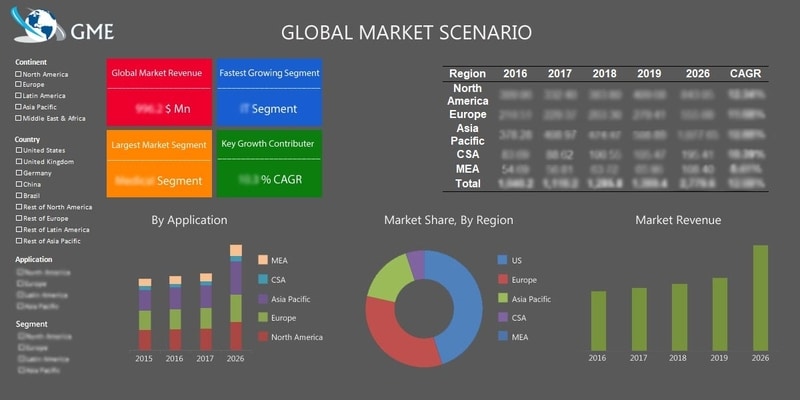Green Clothing Market: Insights
The global green clothing market is estimated to witness a significant CAGR during the forecast period (2019-2026). The growth of the green clothing market is anticipated to increase with the growing concern regarding the environmental changes that are occurring due to plastics. The market is also expected to grow owing to changing fashion trends for sustainable clothing, less water for the manufacturing of clothing and elimination of waste from environment. Decrease in the carbon emission, reduction in the use of raw materials, energy and natural resources are some of the factors that will boost the demand for green clothing. Green clothing is made by first chipping and melting it into white round balls. Then these balls are crushed and spun through shower like nozzle that results into viscose yarn which is used in manufacturing of clothes. Strict government laws and regulations are some of the factors expected to hamper the growth of green clothing market.
Request a free sample copy of the report @https://www.globalmarketestimates.com/chemicals-and-advanced-material/report-summary.php?report_id=1636&report_name=global-green-clothing-market-size

Green Clothing Market: By Material
On the basis of material, the global green clothing market is segmented into polyester, nylon, rayon, and others. The polyester segment is expected to grow during the forecast period, owing to its usage in the manufacturing of clothing and footwear segment. Recycled polyester is usually made from recycled materials including Polyethylene terephthalate (PET) and polyester fabrics. Performance and durability, benefits, including high strength and functional versatility of recycled polyester is the same as that of traditional polyester but with a lower environmental impact. Recycled polyester does not require new petroleum for manufacturing, thus lowering the demand for new petroleum extraction and reducing the overall carbon footprint.
Green Clothing Market: By Application
On the basis of application, the global green clothing market is classified into apparels, workwears, bags, packaging, and others. The apparels segment is expected to hold the largest market share in the application segment. The growth of the segment can be attributed to multiple factors, one of them being increasing environmental impact of plastic. Scarcity of natural resources is one of the major factors expected to propel the growth of the market. It is estimated that five PET bottles have enough fiber to produce one extra-large t-shirt and also with the help of twenty-five two-liter bottles we can make one sweater. Five two-liter PET bottles are also enough fiberfill for a ski jacket. The demand for packaging segment is also expected to increase owing to increase usage of energy efficient manufacturing methods, cleaner and safer means of disposal and less cost are some of the factors for the growth of the segment.
Green Clothing Market: By Region
Asia-Pacific is expected to hold the largest market share. The fast growing textile and fabric industries in China, India, and South Korea are expected to be the prime factors contributing to the growth of green clothing market. India is projected to become the world’s third largest apparel market by 2030, with spending on clothes projected to more than double by the current year of 2020.
Europe is expected to witness considerable growth in the green clothing market. The growth of the market in the region can be attributed to increased technological advancement in the field of manufacturing of ecofriendly fabric yarns. The presence of leading clothing manufacturing companies including Adidas, H&M and Unifi among others are expected to have positive impact on the green clothing market in the region. The market of green clothing is also expected to grow in Middle East and Africa. Increased foreign direct investment is one of the major factors propelling the market growth in MEA region. Increased installation of manufacturing plant by some of the multinational companies is expected to positively influence the growth of the market.
Green Clothing Market: End Use Landscape
The end-user landscape entails a list of current and prospective consumers prevailing across the regions. This section briefs you about company addresses, contact details, products, and regional presence of companies who are purchasing or are likely to purchase green clothing. The key end-users of the markets are H&M, Adidas, and Girlfriend Collective among others.
Green Clothing Market: Vendor Landscape
The report contains a chapter dedicated to vendors operating in the market, covering raw material manufactures, equipment developers, manufacturers, and distributors. The report provides these insights on a regional level. This section of the report entails contact details, experience, products manufactured/supplied, and geographical presence of companies.
Green Clothing Market Share & Competitor Analysis
Some of the key players operating in the green clothing market are ZS Fabrics, Vivify Textiles, Waste2wear, Santanderina, Adidas, Rothy's, Girlfriend Collective, H&M, Everywhere Inc, SynZenBe, Unifi, Recotec, Ecoalf and DGrade among others.
In October 2019, H&M and Ikea formed a strategic partnership for the development of recycled material in the textile industry
In June 2019, H&M collaborated with Maersk in one of their latest innovations, the carbon neutral ocean product for the use of biofuel-blend which results in reducing the emissions from the ocean shipping
No comments:
Post a Comment